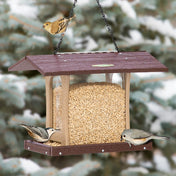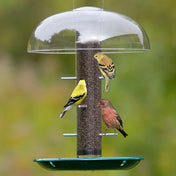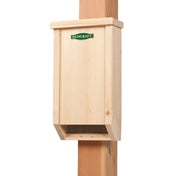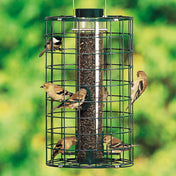
Picture yourself standing at your window on a crisp winter morning, warm coffee in hand, admiring the fresh snow that covers every tree branch. Suddenly, a flash of vibrant blue streaks across the pure white scenery. You watch as this bluebird alights upon a branch, jostling the tree just enough to send a few tufts of fluffy snow floating to the ground below.
How does this bluebird survive such chilly conditions? What does it do when a blizzard blows into town, or when freezing rain plummets from the sky? Do back yard birds need shelter during the coldest days in the winter, just like we do?
The answer to this final question is, yes, they absolutely do need shelter!

What Kind of Shelter Do Birds Need in the Winter?
Birds are survivors, and they will get creative about where they find respite from the elements. Some birds will be delighted to huddle together in a bird house to preserve body heat, while others prefer to “rough it” by seeking shelter in dense shrubs and evergreen trees. While designing your backyard habitat, it is wise to offer a mix of natural shelter and constructed shelter.
- Natural Shelter: Evergreen trees, thickets, shrubs, brush piles, dense hedges, and even dead or dying trees that may contain cavities or hollows.
-
Constructed Shelter: Bird houses, roosting boxes, nesting platforms, nesting shelves and roosting pockets.

What Kinds of Birds Will Use Bird Houses in the Winter?
A wide variety of small, cavity-nesting songbirds like chickadees, bluebirds, titmice, wrens, and nuthatches will use bird houses and roosting boxes in the winter. Some houses or roosting boxes will accommodate many of these species, while others are designed to attract specific birds. Factors such as depth, size of the entry hole, and cavity volume can influence which birds you might expect to take up residence in your shelter.
For example, if you are hoping to attract bluebirds this winter, you might want to select a house designed specifically for bluebirds. There are also options available for attracting wrens and chickadees, as well as a variety of other species. While these houses are all crafted to attract your favorite birds, it is good to keep in mind that you might see some unintended guests once in a while. But who can blame a stray sparrow for popping into a cozy space on a cold winter day?
What Kinds of Birds Will Use Nesting Shelves or Platforms in the Winter?
Nesting shelves and platforms will appeal to the masses in the winter. You are likely to see all sorts of birds retreat to an open faced shelter for a little bit of protection from the elements, especially if they are just taking a moment’s rest from chowing down at your feeder.
Shelves and platforms are particularly beloved by medium to large birds like blue jays, Steller’s jays, robins, downy woodpeckers, mourning doves, and cedar waxwings. These are all examples of birds that do not use enclosed cavities for nest building, and therefore, will not utilize traditional shelters like a bird house. Instead, these birds prefer spaces that feel fairly open to their surroundings, yet are protected from the wind, rain, and snow.
How Else Can I Help Birds Survive the Winter?
Offering shelter to your birds is one thing, but what else can be done to support birds as they navigate the most challenging months of the year? Here are a few more ways to help bring some joy to your birds throughout the winter.
- Bird Feeders: Offer your birds a feeder as a dependable source for sustenance. Once they discover where your feeder is, they will learn to return to it regularly for meals.
- Energy Dense Foods: Foods like suet cakes, mealworms, and seed blends all contain the essential fats and proteins that birds need to help maintain their body temperatures in the winter.
- Heated Bird Bath: Birds absolutely love to splash around in a warm source of water throughout the winter. In addition to offering some warmth, this can act as a rare source of drinking and bathing water when most natural sources are frozen over.
For more tips on this topic, check out our article on Getting Ready for Winter Bird Feeding!
Have questions about helping your birds thrive this winter? Call us at 1-888-879-5095 (Mon–Fri, 9:00 AM–5:00 PM ET) or email info@duncraft.com
Happy Birding!
—The Duncraft Team, Birding Together Since 1952







